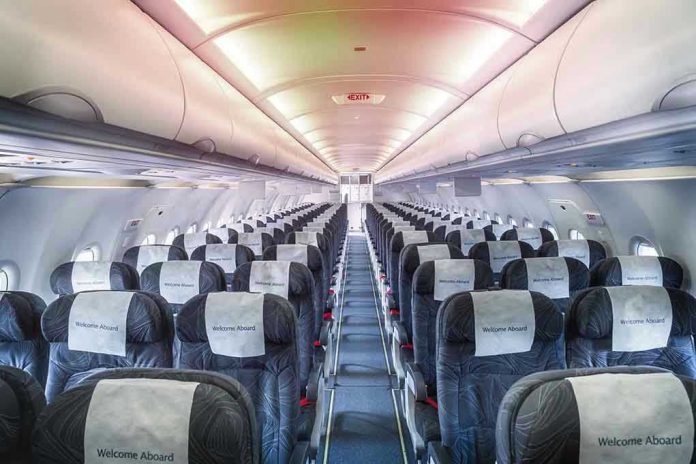
Another shocking case of in-flight violence exposes the ongoing threat to passenger safety and order at 30,000 feet, fueling demands for real accountability and tougher deterrents.
Story Snapshot
- Air rage incidents are on the rise, with passengers and crew facing real danger in confined aircraft cabins.
- Recent altercations, including the August 2025 Breeze Airways assault, highlight gaps in in-flight security and response protocols.
- Social media and viral videos have increased public scrutiny and pressure for reform in airline safety policies.
- Experts and regulators are urging stronger preventive measures and stricter legal consequences for perpetrators.
Confined Chaos: Escalating Air Rage Threatens Safety
Physical confrontations erupting on commercial flights have become all too common, turning what should be routine travel into a battleground thousands of feet above the ground. In the confines of an aircraft cabin, a single unruly passenger can threaten the safety of everyone onboard. These incidents, like the Breeze Airways case where a disruptive passenger assaulted crew and was only subdued by a brave fellow traveler, underscore the inherent dangers and unpredictability that face both passengers and flight staff. The close quarters and lack of onboard security make every flight a potential risk, especially when airlines and authorities are still playing catch-up with the reality of increasing air rage.
Airlines report that alcohol consumption, mental health challenges, and crowded cabins are among the leading catalysts for air rage. While crew members receive training in de-escalation, they are often unprepared for physical altercations that can instantly spiral out of control. Several high-profile incidents over the past decades, from the British Airways Flight 2069 cockpit breach to the more recent U.S. cases, reveal a pattern: when chaos breaks out at altitude, ordinary passengers sometimes become the last line of defense. The heroism displayed by these Good Samaritans is commendable, but reliance on untrained travelers highlights major gaps in airline security protocols.
Who’s Responsible When Order Breaks Down?
Responsibility during these emergencies falls first on the flight crew, who must protect everyone on board, maintain order, and ensure the safety of the aircraft. Their authority is clear, but physical limitations and the absence of dedicated onboard security personnel often force passengers to step in. After such incidents, airline operators must grapple with liability and reputational damage, while law enforcement and federal authorities handle the legal aftermath. Decision-making power shifts rapidly in these moments—from the captain and crew in the air, to airline management and federal prosecutors on the ground. This chain of command is designed for efficiency but is often tested by the realities of in-flight violence.
Motivations behind unruly passenger behavior vary widely. Some incidents are fueled by intoxication, mental health crises, or personal grievances, while others arise from disputes over basic inflight etiquette. Regardless of the trigger, the consequences are severe: perpetrators face arrest, federal charges, and, increasingly, public shaming through viral videos. Passengers who intervene risk their own safety but are often celebrated as heroes by the flying public and media alike, reflecting a broader frustration with perceived gaps in airline and government response.
Rising Public Outcry Spurs Calls for Policy Reform
The visibility of these violent incidents has surged thanks to social media, with cellphone and amateur videos making headlines and rapidly shaping public opinion. The Breeze Airways assault, widely circulated online, reignited debate about the adequacy of current safety measures and the need for stiffer penalties. Airlines now face mounting pressure to enhance crew training, revisit security procedures, and push for regulatory reforms that prioritize passenger safety over bureaucratic red tape. Regulatory bodies are likewise reassessing guidelines for handling unruly passengers, with some experts calling for a permanent onboard security presence.
Raging passenger punches flight attendants over chaotic phone dispute https://t.co/xPDnxOs7PP pic.twitter.com/naW43fcZfU
— New York Post (@nypost) August 26, 2025
Short-term impacts of these incidents include physical injuries, psychological trauma, and costly flight disruptions. Long-term, the aviation industry faces rising insurance costs, the threat of reputational harm, and the challenge of rebuilding public trust in air travel. Experts highlight the urgency of addressing root causes—such as substance abuse and mental health—while advocating for more robust screening and prevention strategies. Legal scholars point to the complex jurisdictional issues that arise when incidents occur in international airspace, underscoring the importance of federal prosecution and international cooperation.
Sources:
British Airways Flight 2069 – Wikipedia
Breeze Airways unruly passenger: Good Samaritan speaks – CBS News
Delta flight attendant assaulted at altitude – Instagram







